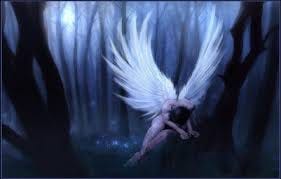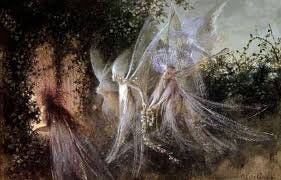During my previous chapter article I referred to Stolen Child, through a poem by W.B. Yeats that is popular worldwide.
I have also heard that it was W.B Yeats that simplified the different names and types of Sidhe, to just a collective called ‘Sidhe’.
The Stolen Child changeling folklore myth itself, was very potent among bootleg poteen whiskey makers.
It was claimed that it was their sons that were the most frequently swapped by the Sidhe, ‘the fairies’.
So to fool the Sidhe, or the ‘fairies’, their sons wore girls skirts most of the time to try and fool the fairies.
I find that an interesting thought though, because how long have young boys been wearing trousers anyway?
Also, how do ‘fairies’ really know it was boys that wore trousers? Did ‘fairies’ just dislike trousers?
Another protection of sons from fairy kidnapping happened when the sons were babies in cradles. A poker was kept across the crib plus a fresh woven Brighid’s cross kept on top of the baby’s blankets for extra protection.
I do feel that these rituals were inspired by fear mongering by priests and people of ‘authority’ claiming that the ‘Sidhe’ and ‘fairies’ were entities of evil, harmful mischief, and bringers of bad luck and bad health.
This fearful fearmongering storytelling seemed to become more intense when stories of the origin of ‘fairies’ shifted from being descendants of the Tuatha De Danann to being described as ‘fallen angels’.
‘Fallen angels’ being angels thrown out of heaven for not being pure enough, but not wicked enough to be condemned to ‘hell’. So their new mission was/is to be back among the humans and protecting nature, and enforcing wrath when nature was abused by humans. Even some Tuatha De Dannan stories have been changed to tell of them being ‘fallen angels’ that arrived on Eire.
Quite near where I live is Kilronan, near Keadue, Co. Roscommon, and a mountain, Sliabh an Iarainn in Co. Leitrim, NE of Drumshambo, are both sites that hold stories of the Tuatha De Danann arriving from the sky as ‘fallen angels’. Sliabh an Iarainn area is about to become a national park based on this and other folklore stories.
Kilronan and Sliabh an Iarainn are also favourite sites for UFO spotters too.
To add more dramatic scaremongering we cannot forget the forever keening Bean Sidhe who makes her presence to take and accompany people to ‘Tir an nOg’.
That folklore also includes the white sidhe horse riders taking the ‘fallen’, those who have passed on, into the west. The Sidhe Horses carrying the ‘passed on’ into that land or realm of ‘Tir an nOg’, land of youth, land of eternity.
Within Scottish folklore, the ‘Bean Sidhe’ is spelled ‘Bean Nighe’ and she is the washer woman at the stream or ford washing clothes of those that are about to be passed on.
That folklore arrived in Ireland too, and became a foundation of some of the Morrigan stories, especially ‘Wooing Of Daghda’ stories.
On the west coast of Scotland, and Ireland, you may have seen the beautiful orange beaked oystercatcher birds patrolling the edge of the sea.
It is told that those birds are there to capture any spirits that managed to escape from ‘Tir na nOg’ and are trying to return to land. Oystercatcher birds are also said to call for the white sidhe and their horses to come and collect the escaping spirits to return them back to ‘Tir an nOg’ again.
There is also the ‘Lean Sidhe’ that carries the enchanting cruel passion of the ‘teasing Fairy Lover’ that I talk about during other Nature Folklore subjects, but not much within this one.
Around Ireland, the underworld Sidhe people, or unseen entities, are said to support farmers and their yields, as long as the sustained untouched wild sanctuaries, such as woodland, copses, and hedgerows for the fae to roam.
At last, there may actually be increasing areas of natural native and often ancient woodland due to new incentives released by the Irish Government. There are now substantially increased grant payments for farmers to bring their hedges and fences away from natural woodland boundaries, and allow space for these natural woodlands to expand themselves. More playground for the sidhe, fae, and fairies?
In Scotland, the Sidhe are said to not be so forgiving as the Irish Sidhe. The Scottish Sidhe do not seem to like the farmers much. Should farmers attempt to take away woodlands to expand their crofts, grazing and growing areas, the farmers will be seized by the ‘Gillie Dhu Sidhe’, and their lives taken away. I think that story may have originated from the Picts culture as they were very active farming people.
Eara Ghael, Earra Ghaidheal, Argyll, describing the ‘land’, ‘coastline’, ‘coastland’, or ‘border’ of the Gaels, and Gaels carrying the name that originally translated as ‘tree people’ are told as being very close to the ‘Sidhe’ as if it is their race too.
I also love the tales of ‘Cú Sidhe’, the personal spirit protector, a dog spirit, or even a wolf spirit.
As much as I love the Sidhe and fairy stories, despite being concerned about the spread of the fearmongering versions, I am not actually a believer of ‘Sidhe’ having individual personalities. I hold a strong belief that when we die our water within our body, which can be 70% of us when we die, leaves our body and our body water meets up and rejoins the earth’s water, the sidhe world again.
Because of this, I believe we let go of our individualism when we die. Believers of the ‘Cauldron Of Poesy’ may totally disagree with my belief. Maybe I will publish an article about that sometime.
One thing that I think most people will agree with is that when people pass away, that we are related to and know and love well, their memories live within us and they last forever. Also, I believe that memories of our ancestors that we have never met, but lived well before our time, seem to linger within us too.
With my beliefs in mind my feeling is, what better way to bring these memories alive than through the folklore medium of the ‘Sidhe’ and the fairy realm, but preferably without all of that fear mongering storytelling.
Having shared that, a bit of my belief soapbox, I can now wrap up this article chapter with the ‘Creideamh Sidhe’, the ‘fairy faith’. Also, let’s not forget the ‘Slaugh Sidhe’ describing ‘the touch of fairyness’ within us all.
Before I leave this chapter article, more thoughts about the ‘Sidhe Mounds’, the fairy hills. Where did they come from? Some of the human built ancient stone cairns are built on these ‘Sidhe mounds’. Some people actually call these stone cairns the “Sidhe Mounds’, and regard them as being entrances for getting to the ‘Sidhe’, and to the goddesses, or at least connecting to them. But this becomes confusing when we consider that most of these stone cairns were built well before Tuatha De Danann arrival on this island times?
Regarding those ancient stone structures being entrances to the ‘goddess’, when people think of Goddesses, today, they usually seem to contemplate on wombs, fertility, and the seeding and birth of new life. I believe all of that folklore rounds up the Goddesses wonderfully as it becomes very useful wordless intimate mentoring and guiding. We sustain connections to all things through this, which I am confident does assist living a more sustainable, caring and loving lifestyle. I am all for ‘applied nature folklore’ myself.
Within the next chapter article in this Sidhe series, I will reference Sidhe folklore more towards its connection with water.
Would you like to join my 'Journaling Nature Folklore' course? This is included when you subscribe to my Substack channel at the very discounted annual rate. 20 optional modules a year, in addition to extra articles and videos plus four shared live and recorded workshop seminars to help you along. 'Journaling Nature Folklore' is themed on using folklore linked prompts that we can apply to help along our daily lives. Of course, lots more information after you join the modest annual subscription. First module to be posted, to get this going, 30th March

















Oh! I had no idea that the myth went that far back!
"...this becomes confusing when we consider that most of these stone cairns were built well before Tuatha De Danann arrival on this island times" That is confusing to me, John. What do you think the time line was?